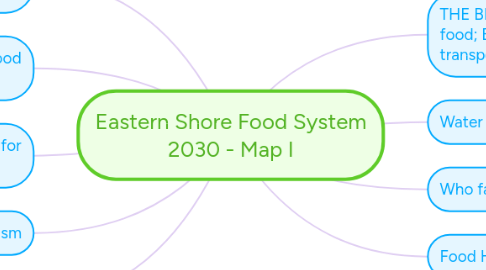
1. Results driven multisectoral, participatory actions
1.1. How and who?
1.1.1. Can food drive economic development?
1.1.1.1. It is the largest source of revenue in Delmarva
1.1.1.2. Yes but price can't be the only driving factor
1.1.1.2.1. How to factor in other benefits?
1.1.1.2.2. Agree
1.2. Private sector or government?
1.2.1. Both
1.2.2. Must have department agriculture support for local crops not agribusiness giants
1.2.2.1. Need to be both and…
1.2.2.2. Agreed
1.3. What results?
1.3.1. Visible, affordable, value added, living wage produce fresh foods (seafood, meat, poultry, vegetables, fruit)
1.3.1.1. Eastern shore producers co– op
1.3.1.2. Eastern shore branding of products
1.3.1.2.1. Like Chesapeake Harvest
1.3.1.2.2. Food hub responsibility
1.3.1.2.3. Will this food be honestly represented?
1.3.1.3. Public – private Eastern shore composting for "leaf grow" product like Montgomery Co.
1.3.1.3.1. Great idea
1.3.1.3.2. Farmers need to become educated on the value of using that these products as well as crop manners less on remove use of commercial fertilizers
1.4. SUMMARY: creating value through branding economic level development. Process will require public/private partnership and multi – sector participation
2. What are the components of the food system? Any missing?
3. Affordable unprocessed food for health
3.1. Is this it a reality?
3.1.1. Easton has limitless opportunities for growing fruit and vegetable and pastured meats
3.1.1.1. Will we overwork land?
3.1.1.1.1. There are sustainable craps
3.1.2. School, community gardens, family gardens
3.1.2.1. Not always a reality since school is out during the growing season
3.1.2.1.1. Okay, spring and fall!
3.2. SUMMARY: Eastern Shore has limitless opportunities for growing in a sustainable manner for fruits, vegetables and pastured meats with many participants partnering, and through channels, with some limitations, such as schools, community, family, as well as commercial gardens
4. Agriculture tourism
4.1. Tourism is a beautiful thing… People come and spend their money, and then they leave
4.2. Destination tourism
4.2.1. Vineyard tours
4.2.1.1. Breweries!
4.2.1.2. Local value added products
4.2.1.3. Clear making
4.3. Adventure agriculture and fishing tourism (4 AM oystering in February)
4.3.1. like this! Combine with education
4.3.2. Farm to table food tours
4.3.2.1. I like this
4.4. SUMMARY: companies to execute; fund farmer interested; attract culmination hospitality meets farmer; Workforce development needed; how do we bring out benefits.
5. Bread basket for mid Atlantic
5.1. Bread basket for Eastern shore poor through living wages
5.1.1. Learning new ways to use food sources
5.1.1.1. Educating local families to use fresh crops
5.1.1.1.1. Culinary skills needed
5.2. Not enough local ownership
5.2.1. Issue of absentee ownership? Or is it a failed agriculture model of commodity grains and company – owned chicken?
5.2.1.1. Tenet farmers
5.2.1.2. And lack of succession planning
5.3. SUMMARY: need brand for this breadbasket; need education for local, healthy cooking to engage local people; need farmer education; Need land access models that support the brand and trained farmer/locals; All with an eye toward building a healthy sustainable economy; Environment; transportation/distribution
5.4. New Topic
6. THE BIG PICTURE: education – Real costs and food; Bread; environmental land accers; transportation (cost to farmers)
7. Water supply
7.1. Tracking threat
7.1.1. On Eastern shore?
7.1.1.1. Yes upstream and upstate
7.2. Education about H2O conservation agriculture
7.2.1. Charge the real cost of water to the consumer. What charge to put on future scarcity?
7.2.1.1. Include cost of water in price of produce
7.2.1.2. Make it ideal for private enterprise to buy water rights
7.2.1.2.1. Yes!
7.2.1.2.2. Yes
7.3. Clean water supply will be an issue for everyone unless significant change happens immediately
7.4. How do you get all sectors to buy off on the importance?
7.4.1. Education. Show economic benefit
7.4.1.1. Benefit of clean water over cost of processing polluted water
7.4.1.1.1. Education of working together
7.4.2. Keep politics out of discussion
7.4.2.1. LOL – good luck!
7.4.2.2. How?
7.4.2.3. Vote the right people into office
7.4.2.3.1. In the last election, Andy Harris won by a 70% margin. Gulp!
7.4.2.4. Why?
7.4.2.5. That's impossible. They can play a critical role
7.5. SUMMARY: water supply – illegal for private enterprise water rights; education in water conservation; fracking
8. Who facilitates this entire process?
8.1. Us
8.1.1. Yes
8.2. Need a partnership
9. Food Hub
9.1. Should help connect local growers is willing buyers
9.1.1. All requires education and training
9.1.2. Buying groups to help farmers and families
9.1.2.1. Network created through ESFS efforts
9.1.2.1.1. Quality management
9.2. Co-op for farmers – specialty crops to sell to restaurants in DC, Baltimore and Philadelphia
9.2.1. Coops can't compete with ConAgra
9.2.2. Allows the farmer to grow and not have to market
9.3. What does this look like?
9.3.1. For profit? Minimal profit? Nonprofit? What's the role of the food hub?
9.3.1.1. Does matter if the farmer is benefiting?
9.3.1.2. Profit will allow the hub funds to expand and educate and support
9.3.1.3. Centralization branding
9.3.1.3.1. Make local produce profitable to grow, get away from cash crops
9.3.2. Recognize food resources based on Easton
9.3.2.1. Rebrand Easton as healthy food
9.3.2.1.1. Good luck with that!
9.3.2.1.2. Transport how?
